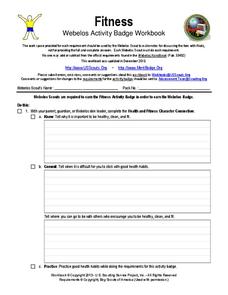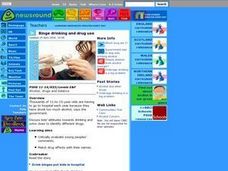Curated OER
Ester Lab
Young scholars investigate making esters in the lab. In this ester lesson plan, students mix 3 organic acids with 3 alcohols and a catalyst to form 3 different esters. Young scholars identify the odors of each ester and write the...
Curated OER
Esters as Food Flavorings
Students produce esters in the laboratory by combining different carboxylic acids with different alcohol. In this esterification lesson plan, students experiment with 3 carboxylic acids and 3 alcohols to produce 3 esters with fruit like...
Curated OER
Fitness
In this fitness worksheet, learners explain why it is important to be healthy, clean, and fit. In addition, they keep a record of their daily meals and snacks for a week and describe what meals are best for them and why. Finally,...
Curated OER
Statistical Drug Abuse and Adolescents in the U.S.A.
Young scholars examine statistics of teenagers using alcohol and marijuana. In groups, they brainstorm the reasons why they believe usage is higher than in years past. As a class, they role-play different roles in scenerios to help them...
Curated OER
Drinking and Driving
Students select resources relating to alcohol relate dissues of drinking and driving. They explain the dangers of mixing drinking and driving. Students discuss the dangaer of drinking and driving using notes from Internet investigations....
Curated OER
Binge Drinking and Drug Use
Learners critically evaluate young peoples' comments on under age drinking. They map out valleys tieing together communities and drinking problems in a variety of situation. In addition, they correlate drinking and education in schools...
Curated OER
Commercial Time. Don't Turn that Channel!
Middle schoolers review information on drug abuse and types of drugs and then learn about alcohol and other drug abuse in a hands on activity. In addition, they learn about kinds of drugs and the effects of drug abuse on the body.
Curated OER
The Human Mind, Alcohol and the Brain
Students create a diagram showing the effects of alcohol on the brain and then create a lesson plan to teach this information to middle school students. They contact middle school teachers and make arrangements for students to actually...
Curated OER
Targets
Young scholars evaluate advertisements for alcohol products. They watch a video, answer discussion questions, and create a collage using magazine alcohol ads with rewritten captions.
Curated OER
Alcohol and Marijuana "Gateway Drugs"
Ninth graders use the internet to research the effects of alcohol and marijuana. They present strategies for resisting peer pressure.
Curated OER
Sobriety Testing Stations
Students identify each of the different sobriety tests and how they are used to detect the amount of alcohol consumed by a person and the physical affects of drinking alcohol.
Curated OER
Alcohol: Separating Fact from Fiction
Students obtain a clearer understanding of their knowledge about alcohol, recognize that their attitudes, beliefs, & knowledge about alcohol may be different from their peers, and gain experience with scientific methods.
Curated OER
Alcohols Revisited (and Ethers) and Going Further... Carboxylic Acids and Their Derivatives
Identifying characteristics of alcohols and their physical properties are reviewed in bullet-point fashion on the first two slides. The same material follows, but for ethers. Finally, the structure and naming of carboxylic acids and...
Curated OER
Alcohol Addiction and Its Effect on the Body
Ninth graders use the Internet to research the liver and the effects of alcoholism. In this alcohol addiction instructional activity students divide into groups and get information on their topic.
Curated OER
Message in a Bottle
Learners consider the implications of the misuse of alcohol. In this personal health lesson, students visit selected websites to discover information about the misuse of alcohol and examine advertisements for alcohol.
Curated OER
Enzymes
Tenth graders test their saliva for enzyme activity. In this enzyme lesson, 10th graders conduct an experiment to test the enzymatic activity of their saliva. They relate the lack of certain digestive enzymes with alcoholism.
Curated OER
Family Sculpture Demonstration
Students simulate the personal interactions in a family with an alcoholic parent. In this alcoholism lesson, students read a family situation. They simulate the interactions in the family and create a living sculpture of the dysfunction.
Curated OER
Harmful objects
First graders identify safe ways to report harmful objects. In this harmful objects lesson plan, 1st graders identify objects that can harm them. They then identify objects that are not safe verses ones that are safe, and are taught...
Curated OER
Effects of Alcohol Use
Fifth graders identify short and long term effects of alcohol use. In this effects of alcohol lesson plan, 5th graders participate in activities to understand what it feels like to have alcohol in their system. With the teacher they make...
Curated OER
I Refuse!
Fifth graders demonstrate effective use of assertive refusal skills when declining alcohol, tobacco and other drugs. In this assertive refusal lesson plan, 5th graders role play peer pressure situation and write a brief essay on what...
Curated OER
Aldehydes and Carboxylic Acids
In this aldehydes and carboxylic acid activity, students complete a chart filling in the missing name and structural formula of the given chemical formulas. In another section, students complete a chart on carboxylic acids as well as...
Curated OER
Alcohol
In this alcohol abuse awareness worksheet, learners read about a man who celebrated his 21st birthday by consuming alcoholic drinks. They read about his drinking throughout the day and then answer 4 questions about the amount of units of...
Curated OER
Other Organic Compounds
In this organic compounds worksheet, students review organic compounds and the group of substituted hydrocarbons each compound belongs to. This worksheet has 10 matching and 4 fill in the blank questions.
Curated OER
Alcohol And Tobacco
In this health worksheet, students collaborate in a group discussion about alcohol and tobacco use. Students provide answers to 7 questions after they have discussed them.

























